Sustainable Gardening in 2025
Can sustainable gardening be easy for beginners in 2025? Absolutely! With today’s innovative approaches and technologies, sustainable gardening has never been more accessible.
Welcome to the green movement of 2025, where sustainable gardening has become a popular lifestyle embraced by millions. As more people care about the environment and look for ways to connect with nature, sustainable gardening offers a blend of eco-friendly practices and personal satisfaction. Whether you have a large yard or a small balcony, these principles can be applied anywhere, letting you build a green space that helps the planet and brings joy to your life.
Sustainable gardening is more than growing plants without chemicals—a holistic approach that works with nature rather than against it. It involves conserving water, building healthy soil, supporting local ecosystems, and reducing waste. In 2025, with climate change impacts becoming increasingly evident, sustainable gardening has evolved to incorporate climate-resilient practices, smart technology, and innovative space-saving solutions that make it easier than ever for beginners to get started.
What makes this approach particularly exciting in 2025 is how technology and traditional gardening wisdom have merged to create accessible solutions for gardeners of all experience levels. From AI-powered plant identification apps to biodegradable growing containers made from mushroom mycelium, the tools available to today’s sustainable gardeners would have seemed like science fiction just a few years ago.
Explore ten easy sustainable gardening tips for beginners in 2025. Whether you want to grow fresh produce, attract wildlife to your garden, or enjoy the calming effects of gardening, these practical steps will help you build a flourishing, eco-friendly space. Start your journey toward a greener future with these simple and impactful ideas!
MYTH BUSTERS: SUSTAINABLE GARDENING EDITION MYTH #1: "Organic gardening means no pesticides at all" REALITY: Organic gardening still uses pesticides, but they're derived from natural sources rather than synthetic chemicals. Some organic pesticides can be harmful if used incorrectly or excessively. The sustainable approach focuses on prevention first, using pesticides (organic or otherwise) only as a last resort. MYTH #2: "Sustainable gardening is more expensive than conventional gardening" REALITY: While initial setup might require investment in quality tools or soil amendments, sustainable gardening typically saves money long-term through reduced water bills, fewer inputs needed, and growing your own food. Many sustainable practices like seed saving, composting, and rainwater harvesting actively reduce gardening costs. MYTH #3: "Native plants create messy, wild-looking gardens" REALITY: Native plant gardens can be just as structured and aesthetically pleasing as conventional gardens. Design principles like grouping, repetition, and defined edges can create formal looks using native plants. Many native species have been developed into cultivars with more predictable growth habits while retaining ecological benefits. MYTH #4: "You need a large yard to garden sustainably" REALITY: Sustainable gardening principles work at any scale, from apartment balconies to urban community gardens to suburban yards. Vertical gardening, container growing, and intensive planting methods can create productive, eco-friendly gardens in very small spaces. MYTH #5: "Sustainable gardening is too complicated for beginners" REALITY: Starting with simple sustainable practices like composting kitchen scraps or growing native pollinator plants can be easier than conventional gardening, which often relies on precise fertilizer formulations and chemical interventions. Sustainable gardening works with natural processes rather than fighting against them. Tip 1: Start with Smart Soil Management
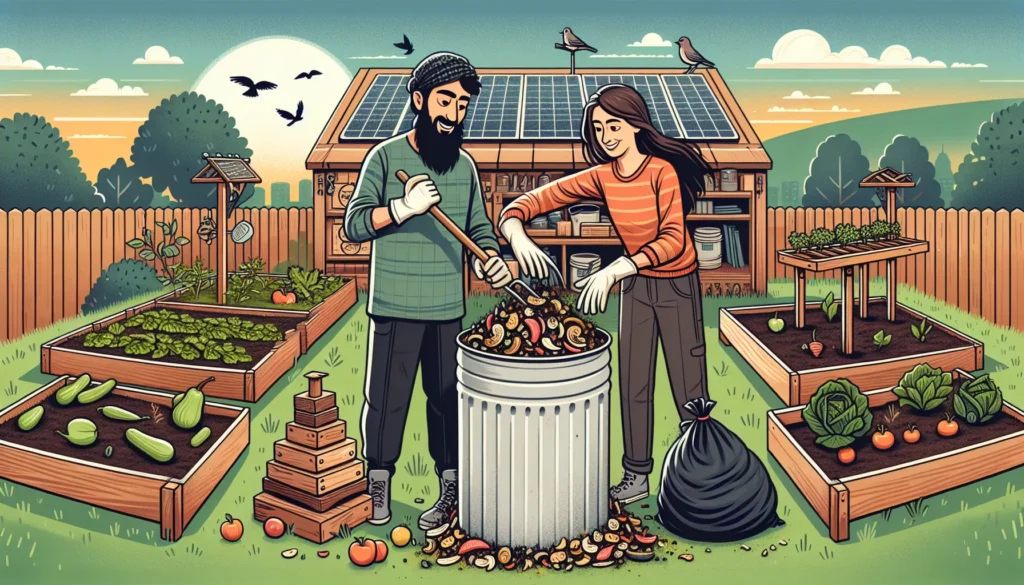
How can beginners build healthy soil without becoming soil scientists? The foundation of any successful sustainable garden lies beneath your feet—in the soil. In 2025, soil health has become a central focus of sustainable gardening, with good reason. Healthy soil produces stronger plants that resist pests and diseases, sequesters carbon, helping to mitigate climate change.
For beginners, understanding your soil doesn’t require a degree in soil science. Modern soil testing kits have become remarkably sophisticated yet user-friendly in 2025. Handheld digital soil analyzers can now instantly assess nutrient levels, pH, moisture content, and even microbial activity, providing customized recommendations for your specific garden. Many community garden centers offer free soil testing services, making this crucial first step accessible to everyone.
By 2025, the no-dig gardening method will have become widely popular, and for good reason. Instead of tilling or digging, this technique incorporates organic matter directly into the soil’s surface, keeping its natural structure intact and supporting beneficial organisms. Studies from the University of California show that no-dig gardens are less labor-intensive, produce up to 30% more crops, and cut weed growth by 50%.
“The foundation of sustainable gardening lies in recognizing that soil is a vibrant, living ecosystem—not merely dirt,” says Dr. Elaine Ingham, a renowned soil microbiologist. “By nourishing the soil with organic matter instead of synthetic fertilizers, we foster billions of microorganisms that naturally support and sustain plant growth.”
To implement soil management as a beginner in 2025:
- Start with a soil test to understand your baseline
- Add a 2-3 inch layer of compost to your garden beds annually
- Use mulch to protect soil from erosion and water loss
- Avoid compacting soil by creating designated pathways
- Consider using biochar, a carbon-rich soil amendment that has become widely available in 2025
The latest innovation in soil management for 2025 is the integration of beneficial fungi networks. Mycorrhizal fungi products, once specialized items, are now standard offerings at garden centers. These remarkable organisms form symbiotic relationships with plant roots, dramatically increasing their ability to access water and nutrients while improving soil structure.
Tip 2: Choose Native and Climate-Adapted Plants
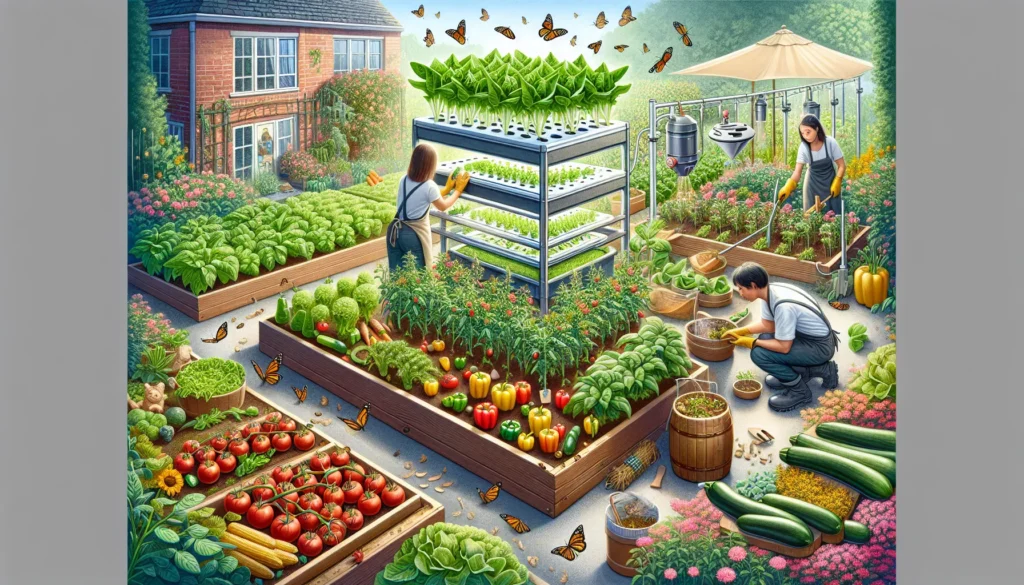
Why are native plants the heroes of sustainable gardening in 2025? It’s all about their resilience and ecological perks. Native plants are perfectly suited to your area’s climate, soil, and wildlife because they’ve evolved there over thousands of years.
In 2025, climate change has intensified weather extremes in many regions, making plant selection more critical than ever. Native plants typically require less water, fertilizer, and pest control than non-native alternatives, making them ideal for sustainable gardens. According to the National Wildlife Federation’s 2024 report, gardens featuring at least 70% native plants require up to 80% less water and maintenance than conventional gardens.
“Native plants are the backbone of local ecosystems,” says Doug Tallamy, author of “Nature’s Best Hope.” “When you plant natives, you’re not just creating a beautiful garden—you’re restoring habitat and supporting the entire food web, from soil microbes to butterflies to birds.”
The concept of “climate-adapted” plants has evolved significantly by 2025. These are varieties specifically bred or selected to thrive in changing climate conditions while maintaining ecological benefits. Many nurseries now label plants with climate adaptation scores, making it easier for beginners to select varieties that will flourish in increasingly unpredictable weather patterns.
To select the right native and climate-adapted plants for your garden:
- Identify your specific growing zone using updated 2025 USDA plant hardiness maps, which now account for climate change projections
- Consult your local extension office or native plant society for recommended species
- Consider microclimates within your garden (areas that may be wetter, drier, shadier, or sunnier)
- Select plants with varying bloom times to provide year-round resources for pollinators
- Include structural diversity with trees, shrubs, and ground covers to create layered habitats
The Native Plant Finder app, launched in 2023 and refined through 2025, has become an invaluable resource for sustainable gardeners. This AI-powered tool uses your location and garden conditions to recommend specific native plants, complete with information about their ecological benefits, maintenance requirements, and compatibility with other species.
WHAT PEOPLE ARE ASKING ABOUT SUSTAINABLE GARDENING IN 2025 "How do I start a sustainable garden with no experience?" Begin with just 3-5 container plants suited to your climate. Use compost-rich potting soil, place in appropriate light conditions, and water consistently. Native herbs and greens are forgiving choices for beginners that provide quick harvests while you learn. "What are the best sustainable gardening apps in 2025?" GardenSync leads the field with its AI plant identification and care recommendations. PlantNet's community science features allow you to contribute to biodiversity research. For beginners, GrowGuide offers step-by-step sustainable gardening projects tailored to your specific location and experience level. "How can I garden sustainably in an apartment?" Utilize vertical space with wall-mounted planters or tension rod systems between windows. Focus on herbs, greens, and compact vegetables bred for containers. Collect shower water while it warms up to water plants, and compost kitchen scraps with a bokashi system or countertop vermicomposter. "Which sustainable gardening methods save the most water?" Drip irrigation combined with smart controllers reduces water use by up to 70% compared to sprinklers. Hydrozoning (grouping plants with similar water needs) prevents overwatering. For maximum savings, rainwater harvesting systems with smart release valves optimize natural precipitation use. "What sustainable gardening certifications are available in 2025?" The Regenerative Garden Certification focuses on carbon sequestration and soil building. Certified Wildlife Habitat programs recognize gardens that support local ecosystems. For food gardens, the Climate-Resilient Edible Landscape certification has gained prominence for gardens that combine productivity with environmental benefits. Tip 3: Implement Water Conservation Strategies
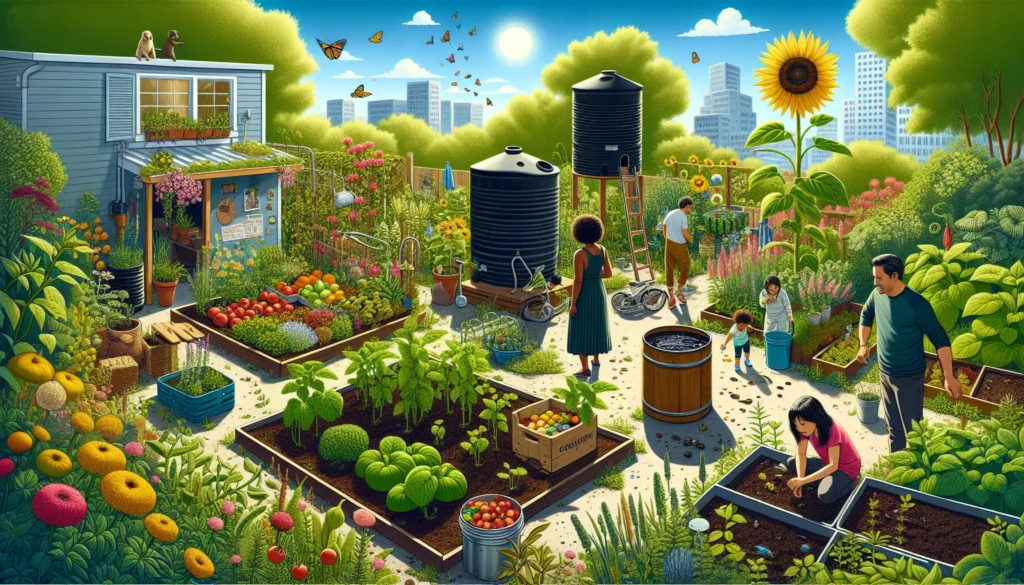
Is it possible to create a thriving garden while using less water? In 2025, the answer is a resounding yes, thanks to innovative water conservation technologies and techniques that have become mainstream.
Water scarcity concerns have intensified in many regions by 2025, making efficient water use a cornerstone of sustainable gardening. The good news is that water-saving approaches have become more effective and accessible than ever before, allowing beginners to create beautiful, productive gardens while dramatically reducing water consumption.
By 2025, irrigation systems will have transformed. Basic models now rely on real-time weather updates, soil sensors, and plant-specific tools to deliver water efficiently. Many connect to smartphone apps, offering water usage insights and tips for saving more.
“The most sustainable approach to garden watering is to mimic natural rainfall patterns,” explains water conservation expert Brad Lancaster. “This means less frequent but deeper watering, which encourages plants to develop deeper root systems and become more drought-resistant.”
Rainwater harvesting in 2025 is easier than ever, thanks to modular systems that anyone can install. These systems collect water from roofs, filter it, and release it to gardens based on soil moisture. Many cities now offer rebates or tax breaks for installing these systems, making them eco-friendly and budget-friendly.
To implement water conservation in your sustainable garden:
- Install a simple rain barrel or a more advanced rainwater harvesting system
- Apply a 2-3 inch layer of mulch around plants to reduce evaporation
- Group plants with similar water needs together (a practice known as hydrozoning)
- Consider installing a drip irrigation system, which uses up to 70% less water than sprinklers
- Incorporate swales or rain gardens to capture and utilize runoff
The concept of “sponge gardening” has gained significant traction by 2025. This approach focuses on creating gardens that capture, store, and slowly release water, mimicking natural ecosystems. Techniques include contour-based design, permeable surfaces, and strategic placement of plants and organic matter to maximize water retention in the landscape.
Tip 4: Create a Composting System
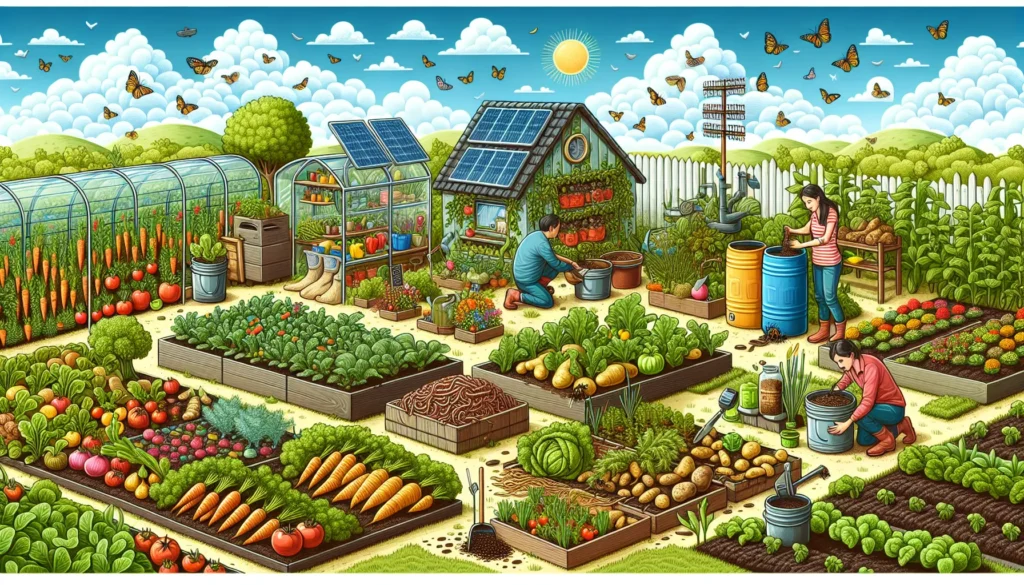
How has composting evolved from a fringe practice to a mainstream necessity by 2025? As landfill space has decreased and awareness of food waste impacts has grown, composting has transformed from an optional gardening activity to an essential component of sustainable living.
For beginners, the good news is that composting has never been easier or more convenient than in 2025. Innovative systems designed specifically for urban environments, apartments, and busy lifestyles have removed many of the barriers that once made composting seem daunting or impractical.
“Composting is the ultimate recycling system,” says composting advocate Bea Johnson. “It transforms what would be waste into a valuable resource while reducing methane emissions from landfills. In 2025, there’s a composting solution for every living situation.”
Backyard composting has evolved for today’s sustainable gardeners. Tumbling composters now make decomposition faster with better airflow and are easier to use. Many models come with features like temperature and moisture sensors that sync with smartphone apps, helping beginners manage their compost and sending alerts when action is needed.
For those with limited space, bokashi composting has gained popularity by 2025. This anaerobic fermentation method uses specialized microorganisms to break down all food waste, including meat and dairy, in a sealed bucket that can be kept indoors without odor concerns. The resulting pre-compost can then be buried in garden soil or added to a traditional compost system.
Vermicomposting has evolved with new designs for worm bins that look stylish enough to fit in kitchens or living spaces. These systems efficiently turn food scraps into nutrient-packed castings for plants and liquid “worm tea,” a natural fertilizer.
To start composting as a beginner in 2025:
- Choose a composting method that fits your space and lifestyle
- Balance “green” materials (food scraps, fresh plant matter) with “brown” materials (dried leaves, paper, cardboard)
- Keep your compost moist but not soggy
- Turn or aerate your compost regularly to speed decomposition
- Harvest finished compost when it resembles dark, rich soil with an earthy smell
Community composting networks have expanded dramatically by 2025, with many neighborhoods establishing shared composting facilities or collection services. These programs allow even those without garden space to participate in the composting revolution, often providing members with finished compost in return for their contributions.
Tip 5: Embrace Vertical and Space-Saving Gardening
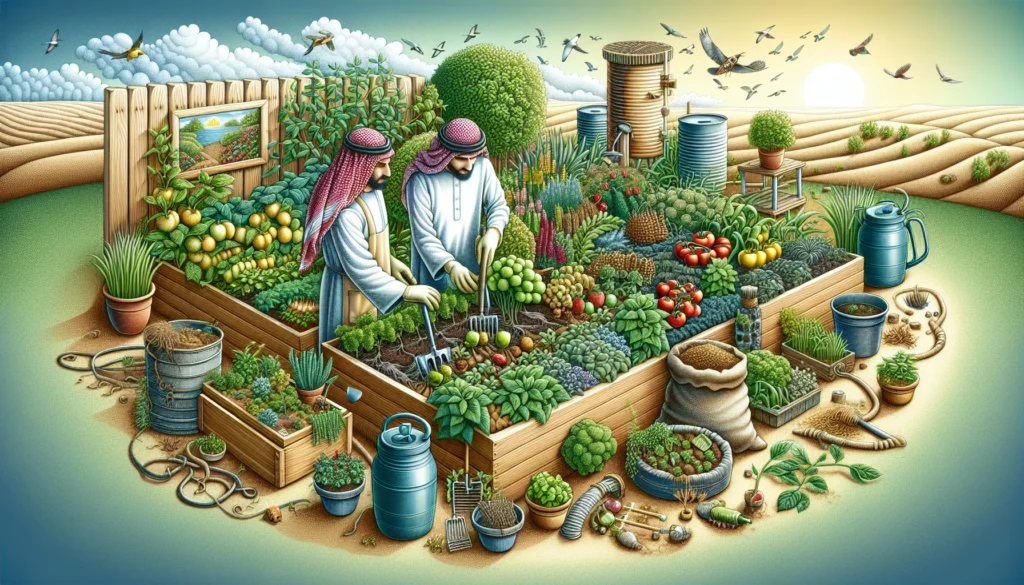
How can you create an abundant garden when space is limited? By 2025, vertical and space-saving gardening techniques will have evolved from clever hacks to sophisticated systems that maximize productivity in minimal space.
Urbanization has continued to increase, with more people living in apartments, condominiums, and homes with small yards. This demographic shift has driven remarkable innovations in space-efficient gardening, making it possible to grow substantial amounts of food and create beautiful ornamental displays in even the most compact environments.
Vertical gardening has evolved with innovative systems that blend structural support, irrigation, and lighting into compact units. These setups can be mounted on walls, railings, or fences, turning unused vertical areas into thriving gardens. Often built with sustainability in focus, they use recycled materials and efficient watering methods to reduce resource consumption.
“The key to successful vertical gardening is to think in three dimensions rather than two,” explains urban gardening expert Kevin Lee Jacobs. “When you start seeing walls, fences, and even ceilings as potential growing spaces, you can triple or quadruple your garden’s productive capacity without expanding its footprint.”
Container gardening is also expected to see significant advancements by 2025. Self-watering containers with water reservoirs that supply moisture as needed have become more efficient and affordable. Fabric grow bags, which promote healthy root systems through “air pruning,” are now available in various sizes and designs suitable for everything from herbs to fruit trees.
For those with sunny windowsills or balconies, microgreens systems offer a way to grow nutrient-dense foods in minimal space. These compact units can produce harvests in as little as 7-10 days, providing fresh, homegrown nutrition year-round regardless of outdoor growing conditions.
To implement vertical and space-saving gardening as a beginner:
- Assess your available space, noting light conditions and structural support options
- Start with a few containers or a small vertical system rather than attempting to fill all available space at once
- Choose compact or dwarf plant varieties bred specifically for container and vertical gardens
- Consider the weight of containers when filled with soil and mature plants, especially for balconies or rooftop gardens
- Implement a regular maintenance schedule, as container plants typically require more frequent watering and feeding than in-ground plants
By 2025, “edible landscaping” will have become widely popular, with gardeners blending food plants into decorative gardens. Blueberry bushes act as foundation plants, trellised beans form natural screens, and vibrant lettuces border flower beds, combining beauty and functionality in small spaces.
QUICK WINS: SUSTAINABLE GARDENING HACKS FOR 2025 1. SOIL BOOSTER SHORTCUT Skip expensive soil amendments by creating "compost tea" – steep finished compost in water for 24-48 hours, strain, and use the nutrient-rich liquid to feed plants. The latest mesh brewing bags make this process mess-free. 2. SMART SEED STARTING Repurpose household items for seed starting: egg cartons, toilet paper tubes, or newspaper pots. The 2025 trend of biodegradable seed tape made from rice paper and water-soluble glue allows precise spacing without thinning seedlings later. 3. WATER-WISE CONTAINER TRICK Insert a perforated plastic bottle into container soil before planting. Fill the bottle with water for deep root irrigation that reduces surface evaporation and encourages drought resistance. New self-filling versions connect to rainwater systems. 4. INSTANT BIODIVERSITY BOOST Plant "insectary strips" – narrow bands of diverse flowering plants – between vegetable rows or along garden edges. These attract beneficial insects that control pests naturally. Pre-seeded biodiversity tape makes this simple to implement. 5. ZERO-WASTE GARDEN HACK Create self-sustaining plant fertilizer stations by burying perforated compostable bags filled with kitchen scraps near heavy feeders like tomatoes. As the scraps break down, they release nutrients directly to plant roots. 6. CLIMATE BUFFER TECHNIQUE Use thermal mass objects like dark-colored stones or water-filled containers near sensitive plants. These absorb heat during the day and release it at night, creating microclimate buffers that protect plants from temperature fluctuations. 7. COMMUNITY CONNECTION SHORTCUT Use garden-sharing apps to find neighbors with complementary resources – someone with extra space might partner with someone who has gardening knowledge but no yard. These collaborative arrangements have become a cornerstone of neighborhood resilience in 2025. Tip 6: Integrate Smart Garden Technology
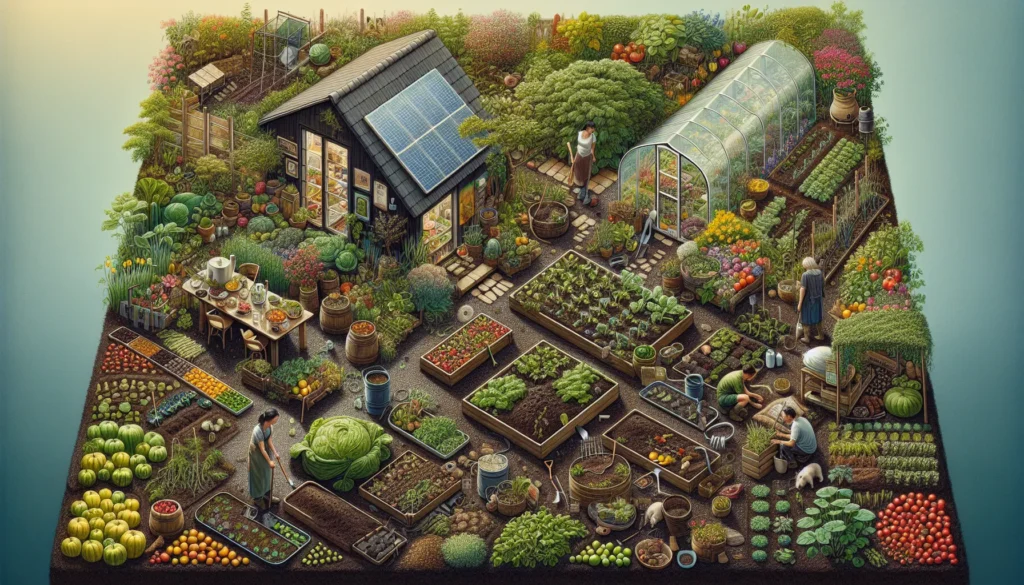
How has technology transformed sustainable gardening by 2025? Technology has revolutionized gardening, blending innovation with tradition to make sustainable practices more accessible, especially for beginners.
By 2025, smart garden technology will have transformed into practical tools that boost sustainability. These innovations guide beginners, reduce waste, and improve results with minimal effort, all while preserving the joy of connecting with nature through gardening.
AI garden assistants have become remarkably sophisticated yet affordable. These systems use computer vision to identify plants, detect early signs of pest problems or nutrient deficiencies, and provide customized care recommendations. Many operate through smartphone apps that allow users to point their camera at a plant to receive instant identification and guidance.
“Smart technology doesn’t replace the gardener—it empowers them,” explains technology and sustainability expert Emma Wilson. By providing real-time data and personalized recommendations, these tools help beginners develop the knowledge and intuition that once took years to acquire.
By 2025, automated systems will be widely used in sustainable gardens. These sensors track soil moisture, light, temperature, and humidity to understand the garden’s conditions. This data improves watering, predicts frost, and identifies the best times to plant crops.
For indoor gardeners, self-contained garden systems have evolved into highly efficient food-producing units. These systems combine hydroponics or aquaponics with LED lighting calibrated to specific plant needs, automated nutrient delivery, and climate control. Many models are designed with circular economy principles, using minimal water and energy while producing fresh herbs, greens, and even small fruits year-round.
To integrate technology into your sustainable garden as a beginner:
- Start with a soil sensor and weather station to understand your garden’s conditions
- Use plant identification apps to learn about existing plants and potential additions
- Consider automated irrigation that adjusts based on weather forecasts and soil moisture
- Explore community science platforms that allow you to share your garden data and learn from others
- Look for tools powered by renewable energy or with energy-efficient designs
The concept of “appropriate technology” has gained traction in sustainable gardening by 2025, emphasizing tools that provide genuine benefits while minimizing resource use and electronic waste. Many garden products now feature modular designs, replaceable components, and recyclable materials, extending their useful life and reducing environmental impact.
Tip 7: Practice Natural Pest Management
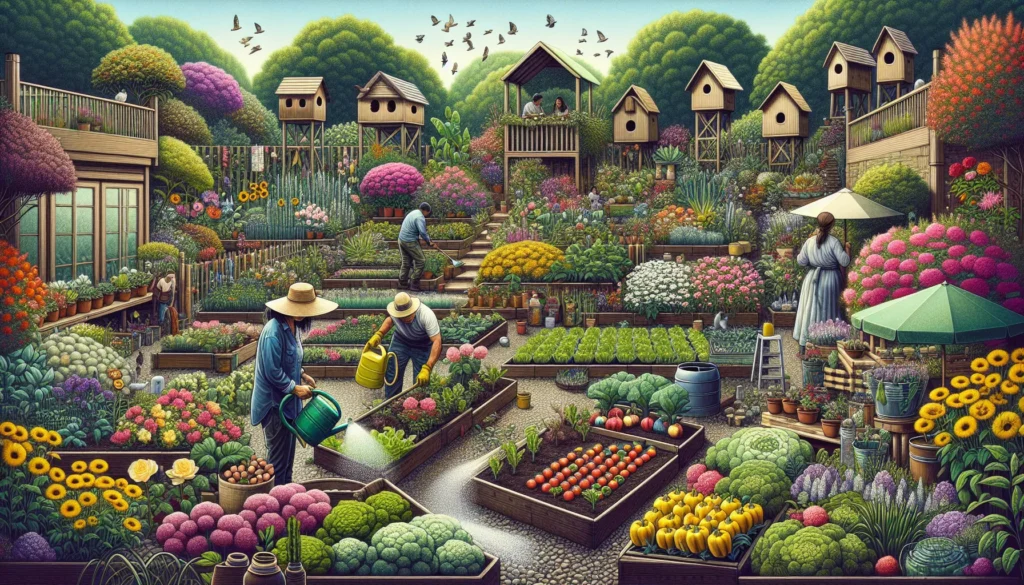
Can garden pests be controlled without synthetic chemicals? Yes, by 2025, improved knowledge of ecological systems and new natural methods will make it entirely possible.
Natural pest management represents a fundamental shift from reacting to pest problems to preventing them through ecological balance. This approach recognizes that a healthy garden ecosystem naturally limits pest populations, reducing or eliminating the need for intervention.
Companion planting will evolve from folk wisdom to a science-backed strategy by 2025. Research from agricultural universities has identified specific plant combinations that effectively repel pests, attract beneficial insects, or improve growth and flavor. Digital planning tools now include companion planting algorithms that suggest optimal plant arrangements based on your selections.
“The best pest control starts before pests appear,” says entomologist Dr. Jessica Harper. “By promoting habitat diversity and healthy soil, you create a strong ecosystem where beneficial organisms naturally manage pests.”
Beneficial insects have become the sustainable gardener’s allies, with predatory species like ladybugs, lacewings, and parasitic wasps providing natural control of common pests. By 2025, “insectary plants” that specifically attract and support these beneficial insects will have become standard components of sustainable garden design. Many garden centers now offer “beneficial insect packages” with specific plant combinations to attract different helper species.
By 2025, physical barriers and traps will have improved effectiveness and design. Recycled floating row covers shield crops from flying pests while letting light, air, and water pass through. Stylish copper tape barriers keep slugs and snails away. Pheromone traps use insect signals to track and reduce pest numbers without affecting helpful species.
When direct action is needed, organic pest control methods offer more choices today. Microbial insecticides use helpful bacteria, fungi, or viruses to target pests without harming insects. Plant-based sprays made from natural extracts give short-term protection during key growth periods.
To implement natural pest management as a beginner:
- Focus first on building healthy soil, as robust plants naturally resist pests
- Incorporate diverse plantings, including flowers that attract beneficial insects
- Practice regular observation to catch potential problems early
- Use physical barriers as a first line of defense for high-value crops
- Consider biological controls like beneficial nematodes for persistent soil pest issues
By 2025, “pest acceptance thresholds” will have become a key idea in sustainable gardening. This method recognizes that some pests are part of a healthy garden, helping predators thrive and strengthening plants. Gardeners often use tools to monitor pests and only take action if their numbers grow enough to harm plants.
Tip 8: Design for Biodiversity
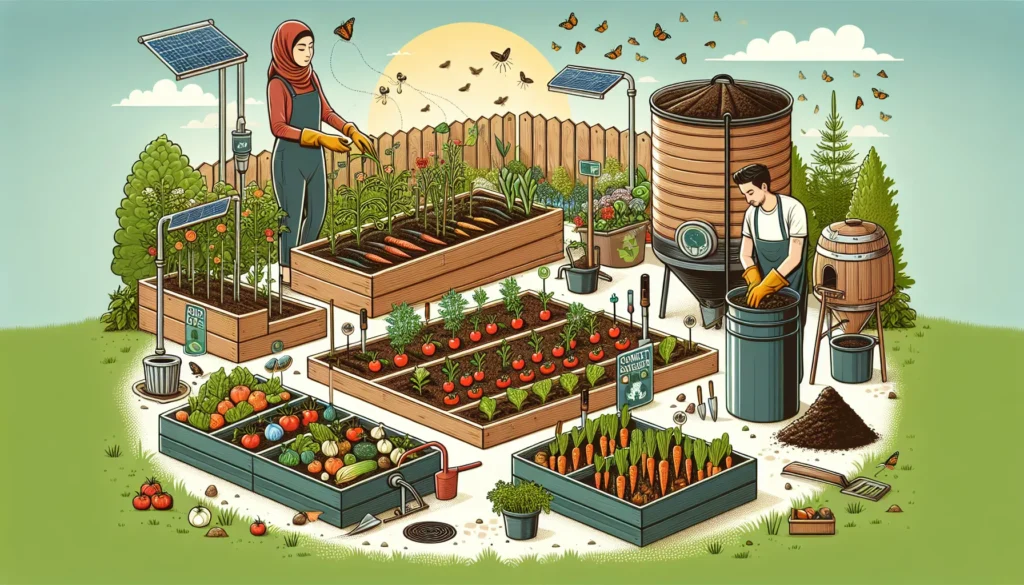
Why has biodiversity become the cornerstone of sustainable garden design by 2025? As habitat loss has accelerated globally, home gardens have emerged as crucial refuges for wildlife and essential contributors to ecological resilience.
Designing for biodiversity involves creating gardens that support many forms of life, including soil microbes, insects, birds, and small animals. This method helps conservation while making gardens more resilient, productive, and enjoyable.
Creating wildlife habitats has moved beyond simple bird feeders to comprehensive design strategies that provide the four essential elements: food, water, shelter, and places to raise young. By 2025, certification programs for wildlife-friendly gardens have expanded, with many municipalities offering incentives for residents who transform their properties into biodiversity hotspots.
“Every sustainable garden, no matter how small, can serve as a stepping stone for wildlife moving through fragmented landscapes,” explains urban ecologist Dr. Marcus Chen. “When we connect these habitats across neighborhoods, we create corridors that allow species to adapt and migrate in response to climate change.”
Pollinator-friendly plantings have gained urgency as pollinator populations have continued to decline. By 2025, sustainable gardeners will recognize the importance of providing season-long blooms with diverse flower shapes, sizes, and colors to support different pollinator species. Native flowering plants form the foundation of these designs, supplemented with non-invasive garden varieties that extend the blooming season.
Layered garden design mimics natural ecosystems by incorporating plants of different heights and growth habits. This approach creates multiple habitat niches while maximizing the productive use of space. A typical layered garden might include canopy trees, understory trees or large shrubs, small shrubs, herbaceous plants, ground covers, root crops, and vines—all occupying different spatial zones.
Micro-ecosystem development focuses on creating specialized habitat features that support specific ecological functions. Rain gardens capture and filter stormwater while providing habitat for moisture-loving species. Brush piles and log stacks create decomposition systems that support fungi, insects, and small animals. Rock gardens provide basking spots for reptiles and nesting sites for ground-dwelling bees.
To design for biodiversity as a beginner:
- Include at least three native plant species that are host plants for local butterfly and moth species
- Install a water feature, even something as simple as a bird bath or small pond
- Create a varied vertical structure with plants of different heights
- Leave some areas of “managed messiness” with leaf litter and natural debris
- Reduce outdoor lighting or use wildlife-friendly lighting options to support nocturnal species
The “Homegrown National Park” movement inspires homeowners to turn parts of their yards into native plant habitats. By 2025, this effort will have grown rapidly, creating biodiversity hubs in cities and suburbs. It shows how small individual changes can lead to environmental impacts.
Tip 9: Implement Energy-Efficient Garden Features
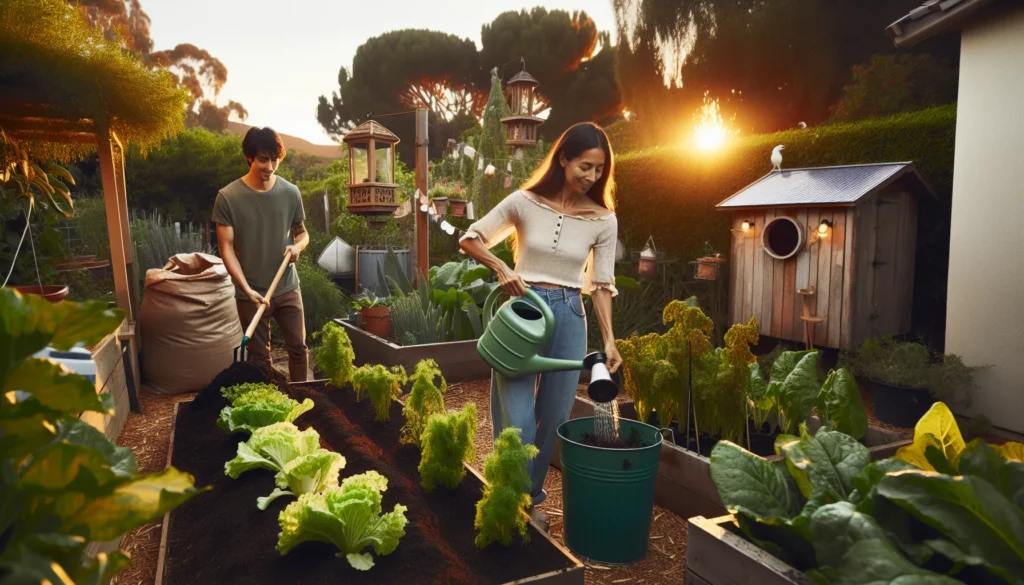
How can garden design contribute to energy conservation? By 2025, sustainable gardens will have evolved beyond water and soil conservation to become integrated energy systems that reduce household energy consumption while creating comfortable outdoor living spaces.
Eco-friendly garden designs blend traditional practices with innovative technology to use renewable energy, manage temperature swings, and lower the environmental impact of garden upkeep. As climate change grows more urgent, these methods provide effective ways to adapt and reduce its effects.
By 2025, solar-powered garden tools and lighting will be features in eco-friendly gardens. Improved battery technology and more efficient solar panels have made them stronger and more dependable than traditional fuel-based options. Many systems now store extra energy for use during cloudy days or nighttime.
“The sustainable garden of 2025 is both beautiful and functional from an energy perspective,” says landscape architect Sophia Rodriguez. “Strategic design can reduce home cooling costs by up to 30% while creating more comfortable outdoor spaces for human enjoyment.”
Passive heating and cooling techniques draw on traditional design wisdom adapted for contemporary settings. Deciduous trees planted on the southern and western sides of homes provide summer shade that reduces cooling costs, while allowing beneficial solar gain in winter after leaves fall. Trellises with annual vines offer similar benefits with a smaller footprint, making them suitable for urban gardens.
Wind and water features contribute to both energy efficiency and garden ambiance. Properly placed living windbreaks reduce heating costs by blocking winter winds, while water features provide evaporative cooling effects during hot weather. Some innovative gardens in 2025 incorporate small-scale wind or water power generation systems that harness these natural elements to produce electricity for garden use.
Garden structures use more sustainable materials, moving past recycled and reclaimed options to include innovative eco-friendly choices. Mycelium-based materials, grown from fungi on agricultural waste, are lightweight, strong, and compostable. Compressed earth blocks, made from local soil with little processing, help regulate temperatures by providing thermal mass.
To implement energy-efficient garden features as a beginner:
- Start with solar-powered path lights or a small solar fountain pump
- Plant deciduous trees or vines in locations where they’ll shade windows during summer
- Use recycled or locally sourced materials for garden structures and hardscaping
- Create outdoor living spaces that reduce the need for indoor climate control during mild weather
- Consider human-powered tools like push mowers and hand cultivators for small gardens
By 2025, the idea of the “garden as power plant” has taken shape, blending energy generation with traditional garden uses. Solar pergolas combine photovoltaic panels with structures for climbing plants. Wind energy is harnessed through kinetic sculptures. Compost systems are designed to capture heat, helping extend the growing season in cooler areas.
Tip 10: Join the Community Gardening Network
How has community gardening evolved into interconnected networks by 2025? Digital platforms, resource-sharing tools, and collaborative approaches have built a thriving support system for gardeners, fostering sustainability and inclusivity for all skill levels.
Community gardening has expanded beyond shared plots to encompass various collective action and mutual aid. These networks provide beginners with access to knowledge, resources, and encouragement that significantly increase their chances of success while strengthening community resilience.
Local gardening communities are thriving in both physical and virtual spaces. Revitalized neighborhood garden clubs now boast diverse memberships and embrace inclusive practices. Community gardens have transformed into versatile areas, functioning as outdoor classrooms, food distribution centers, and social hubs. Increasingly, municipalities are integrating community garden initiatives into their climate action plans, offering land, infrastructure, and resources to support their growth.
“The best gardens bring people and plants together,” says community garden organizer Jamal Washington. “Gardening as a group lets us share resources and grow stronger connections, helping communities stay resilient in tough times.”
Online sustainable gardening resources will have become more specialized and interactive by 2025. Virtual garden mentorship programs connect beginners with experienced gardeners for personalized guidance. Augmented reality apps allow users to visualize potential garden designs in their actual spaces and receive feedback from design professionals. Video libraries offer step-by-step tutorials for specific techniques, with content filtered by climate zone, garden size, and experience level.
Seed and plant exchanges have expanded through both local networks and digital platforms. Seed libraries, once primarily housed in public libraries, now operate through distributed models with neighborhood collection points. Mobile apps facilitate plant swaps, allowing gardeners to list available divisions or seedlings and arrange exchanges. These systems reduce costs for beginners while preserving genetic diversity and locally adapted varieties.
Collaborative gardening initiatives address the challenges of time, knowledge, and physical ability that can be barriers for beginning gardeners. Garden-sharing programs match landowners’ unused space with people who want to garden but lack access to land. Crop-sharing arrangements allow participants to focus on growing a few crops well and trading for others. Garden maintenance cooperatives distribute the physical work of gardening among members with different abilities and schedules.
To join the community gardening network as a beginner:
- Search for local garden clubs, community gardens, or master gardener programs in your area
- Participate in online forums specific to your climate zone and gardening interests
- Attend seed swaps, plant sales, or garden tours to connect with other gardeners
- Volunteer at community gardens or school garden programs to gain hands-on experience
- Consider starting small with a shared garden project involving neighbors or friends
The “garden matchmaking” concept is expected to gain traction by 2025, with platforms that connect people based on complementary gardening resources and needs. Someone with gardening knowledge but limited time might partner with someone with available space but lacks experience. These arrangements create mutually beneficial relationships that make sustainable gardening more accessible to diverse participants.
Frequently Asked Questions
What exactly is sustainable gardening, and how is it different from regular gardening?
Sustainable gardening is an approach that works with natural processes to create gardens that conserve resources, support biodiversity, and minimize environmental impact. Unlike conventional gardening, which often relies on synthetic fertilizers, pesticides, and intensive resource use, sustainable gardening focuses on building healthy soil, conserving water, using native and adapted plants, and creating balanced ecosystems. In 2025, sustainable gardening has evolved to incorporate climate resilience, technology, and community collaboration while maintaining these core principles.
Absolutely! You can create a thriving, sustainable garden. Start by utilizing vertical space with hanging planters, wall-mounted shelves, or tiered plant stands to maximize your growing area. Choose compact plants like herbs, salad greens, or dwarf vegetables that thrive in containers. Use recycled materials for your pots and opt for organic soil and natural fertilizers to reduce your environmental impact. Collect rainwater or reuse kitchen water for watering your plants, and consider composting kitchen scraps to create nutrient-rich soil. With creativity, your balcony can become a green oasis that supports sustainable living!
How much time does sustainable gardening require? I have a busy schedule.
One of the benefits of sustainable gardening is that it often requires less maintenance than conventional approaches once established. Start small with just a few containers or a single raised bed. Many sustainable gardening techniques—like mulching, choosing adapted plants, and installing smart irrigation—actually reduce the time spent on maintenance. The collaborative gardening movement of 2025 has also created options for shared maintenance, where neighbors or community members divide tasks based on their schedules and abilities.
Is sustainable gardening more expensive than conventional gardening?
While there may be some upfront costs for quality tools, soil improvements, or water-saving systems, sustainable gardening saves money in the long run. You’ll spend less on water, fertilizers, and pest control products. Growing your own food reduces grocery bills. Practices like seed saving, composting, and rainwater harvesting further reduce expenses. Many municipalities now offer rebates or incentives for sustainable garden features like rain gardens or pollinator habitats, making the initial investment even more affordable.
How do I control pests without using chemical pesticides?
Sustainable pest management focuses on prevention first. Start by building healthy soil to grow strong, resilient plants. Incorporate diverse plantings to attract beneficial insects that prey on pests. Use physical barriers like row covers or copper tape for vulnerable crops. Monitor regularly to catch problems early. If intervention is needed, target specific pests with the least toxic options like insecticidal soaps or neem oil. By 2025, many gardeners will be using AI-powered monitoring systems that can identify potential pest issues before they become serious problems.
What are the best plants to start with for a beginner sustainable gardener?
Native plants adapted to your specific region are always excellent choices, as they typically require less water and maintenance while supporting local wildlife. For edible gardens, herbs like basil, mint, and rosemary are forgiving and productive. Greens such as lettuce, kale, and spinach can be harvested multiple times. In 2025, many nurseries will offer “climate-adapted” plant collections specifically designed for beginners in different regions, taking the guesswork out of plant selection.
How can I make my existing garden more sustainable without starting over?
You don’t need to redesign your entire garden at once. Start by adding compost to build soil health, installing a rain barrel to collect water, or replacing some high-maintenance plants with native alternatives as existing plants need replacement. Reduce lawn areas gradually by expanding beds or creating pocket gardens. Add pollinator-friendly plants to attract beneficial insects. Implement mulching to reduce water use and suppress weeds. These incremental changes will transform your garden into a more sustainable space over time while working within your budget and energy constraints.
Conclusion: Embracing the Future of Gardening
As we’ve explored throughout this article, sustainable gardening in 2025 offers exciting opportunities for beginners to create beautiful, productive, and environmentally responsible gardens. The ten tips we’ve covered—from soil management and native plant selection to water conservation, composting, space-saving techniques, technology, natural pest management, biodiversity design, energy efficiency, and community engagement—provide a comprehensive framework for starting your sustainable gardening journey.
Sustainable gardening has become easier and more accessible than ever. New technologies have simplified tasks, and a growing focus on eco-friendly practices has built welcoming communities for beginners. Whether you have a large yard or a small balcony, you can tailor sustainable gardening to fit your space.
Sustainable gardening is rewarding for many reasons. It helps protect biodiversity, supports the environment, and strengthens communities. The food you grow will be fresher and healthier than what you buy in stores. Connecting with other gardeners can deepen your knowledge and bring joy. Plus, gardening boosts both physical and mental well-being.
Creating a sustainable garden is about making progress, not achieving perfection. Small actions like planting pollinator-friendly plants, starting a compost bin, or using a rain barrel can make a big difference. These efforts go beyond your garden, inspiring change in neighborhoods, communities, and the wider environment.
Call to Action
Now is the perfect time to begin your sustainable gardening adventure. Start small, but start today. Choose just one or two of the tips we’ve discussed and implement them in your space. As you gain confidence and experience, gradually incorporate additional sustainable practices.
Join local gardening groups or online communities to connect with others. Share tips, ask questions, and learn from each other’s experiences. Sustainable gardening in 2025 thrives on collaboration, so you’ll always have support.
Document your progress through photos, notes, or a garden journal. This record will not only help you learn from your experiences but also allow you to appreciate how far you’ve come. Celebrate each milestone, whether it’s your first homegrown salad, a visit from a beneficial pollinator, or a noticeable reduction in your water bill.
Consider joining certification programs like the Regenerative Garden Certification or Certified Wildlife Habitat initiatives. These programs provide structured guidance for creating sustainable gardens while recognizing your contributions to environmental stewardship.
Most importantly, enjoy the process. Sustainable gardening is as much about the journey as the destination. Each season brings new opportunities to learn, grow, and connect with the natural world.
Discussion Questions
- Which sustainable gardening practice do you find most intriguing, and why? What might be your first step in implementing it?
- How might sustainable gardening practices vary across different climate zones? What specific challenges and opportunities exist in your region?
- In what ways could sustainable gardening contribute to community resilience in the face of climate change and other environmental challenges?
- How do you envision technology and traditional gardening wisdom evolving beyond 2025?
- What role might sustainable home gardens play in addressing larger environmental issues like biodiversity loss, water scarcity, or food security?
- How could schools, businesses, and public spaces incorporate sustainable gardening principles to create more resilient and vibrant communities?
- What barriers might prevent people from adopting sustainable gardening practices, and how might these be addressed?
As you contemplate these questions and begin your sustainable gardening journey, remember that each plant you nurture and each sustainable practice you adopt contributes to a healthier planet. The garden of 2025 is more than just a collection of plants—it’s a living demonstration of how human creativity and natural processes can work together to create abundance, beauty, and resilience. Happy gardening!


